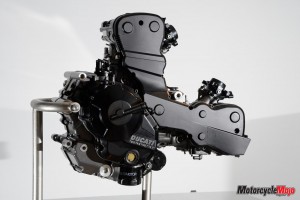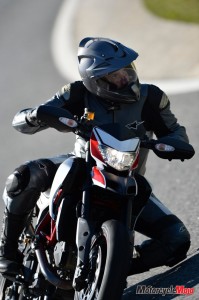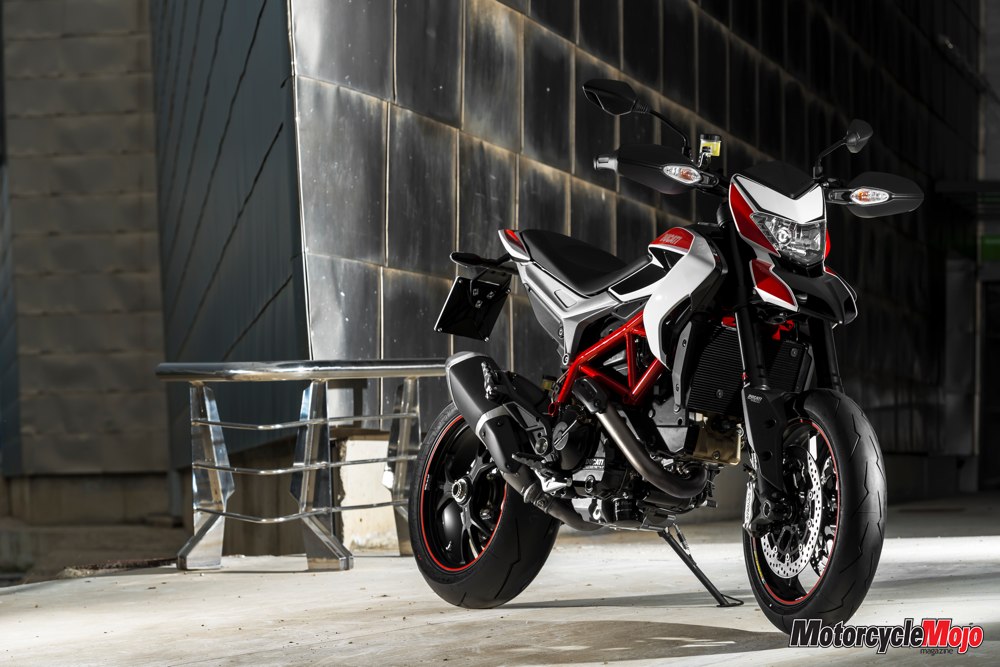Many readers may not remember this, but motorcycles like the latest Ducati Hypermotard were actually inspired by what amounted to a late ’70s, early ’80s version of American reality television. No, not anything like American Idol or The Amazing Race, though the TV show was inspired by competition.
In 1979, ABC television network executives brainstormed and came up with an idea that put top racers from different disciplines in a competition that combined elements of road racing, dirt track and motocross, to crown the all-out top rider. The show aired on Wide World of Sports and was called Superbikers; it attracted riders like Eddie Lawson, Kenny Roberts and Jeff Ward, among other race champions.
Motorcycles were modified, two-stroke motocrossers set up with bigger brakes and wheels that accepted modified dirt-track tires capable of handling both paved and dirt portions of the circuit. Although the television series only lasted until 1985, the specialty motorcycles built a following in Europe. In France they evolved into supermotards, and the racing continued.
Supermotard streetbikes emerged soon after, still based on single-cylinder dirtbikes. Ducati was the first to introduce a twin-cylinder motard, first as a concept in 2005, and then as a production model in 2007. Called the Hypermotard 1100, it had a two-valve, 1078 cc, air-cooled V-twin, with the 803 cc Hypermotard 796 added in 2010.
 The 2013 Hypermotard, launched earlier this year in Spain, has been completely redesigned, and now only one engine displacement is available. It now uses an all-new, liquid-cooled, four-valve V-twin displacing 821 cc. Based on the Multistrada’s 1198 cc Testastretta 11-degree V-twin, it is the most powerful engine yet to propel a Hypermotard model, claiming 110 peak horsepower, 15 hp more than the 1100 and 29 more than the 796.
The 2013 Hypermotard, launched earlier this year in Spain, has been completely redesigned, and now only one engine displacement is available. It now uses an all-new, liquid-cooled, four-valve V-twin displacing 821 cc. Based on the Multistrada’s 1198 cc Testastretta 11-degree V-twin, it is the most powerful engine yet to propel a Hypermotard model, claiming 110 peak horsepower, 15 hp more than the 1100 and 29 more than the 796.
However, the engine’s smaller displacement means it has a shorter stroke than the 1100’s engine, and it gives up a bit of peak torque, now at a claimed 65.8 ft-lb versus 75.9 for the 1100, though it still produces 10 ft-lb more peak torque than the 796. Fuel economy numbers have not been released, but I was told they fall somewhere between the Hypermotard 796 and 1100 – closer to the 1100.
Some good news for potential Hypermotard owners is that service intervals have been increased by 6000 km over the Multistrada’s Testastretta mill, now at 30,000 km. Even more good news is that the fuel tank, which on the previous Hypermotard was among the smallest for a full-sized streetbike at 12.4 litres, has grown to 16 litres, meaning you can now ride farther on a tank of fuel.
The new bike also takes a huge technological leap forward – available as standard equipment is DSP (Ducati Safety Pack), which includes three ride modes, eight levels of traction control (DTC) and three levels of ABS. Ride modes have preset parameters for DTC, and ABS that can also be custom tailored to individual preference. DTC and ABS can also be turned off if you’re feeling particularly brave.
Despite the added performance and techno-trickery, the Hypermotard is reasonably priced. The standard model retails for $12,995, which is $1,500 more than the 796, while offering performance levels exceeding the 1100. The higher-spec SP model, with upgraded suspension, lighter wheels and some carbon-fibre components, costs $15,695, a reduction of $1,800 over the outgoing 1100Evo SP.
A new look still retains enough design elements to clearly identify this as a Hypermotard, though from the right-hand side, the biggest (and rather welcome) change is the relocated muffler, now in a lower position. Gone, too, are the folding bar-end mirrors, replaced by more traditional and more functional rearviews mounted atop the handlebar controls.
 A new chassis includes revised steering geometry, and the engine is wrapped in a new steel trellis frame that uses a techno-polymer and die-cast aluminum rear subframe. Steering geometry has been altered to improve stability; steering rake has been kicked out to 25.5 degrees from 24, and the wheelbase has been stretched to 1500 mm (59 in.), an increase of 45 mm from the outgoing model. The SP model gets a fully adjustable 50 mm Marzocchi inverted fork (43 mm non-adjustable Kayaba unit for the standard model), and a fully adjustable Ohlins shock (rebound damping and preload-adjustable Sachs shock on the standard bike).
A new chassis includes revised steering geometry, and the engine is wrapped in a new steel trellis frame that uses a techno-polymer and die-cast aluminum rear subframe. Steering geometry has been altered to improve stability; steering rake has been kicked out to 25.5 degrees from 24, and the wheelbase has been stretched to 1500 mm (59 in.), an increase of 45 mm from the outgoing model. The SP model gets a fully adjustable 50 mm Marzocchi inverted fork (43 mm non-adjustable Kayaba unit for the standard model), and a fully adjustable Ohlins shock (rebound damping and preload-adjustable Sachs shock on the standard bike).
The liquid cooling and techno-gadgetry have added three kilos compared to the 1100, so that the standard model is now 175 kg (386 lb.) dry. The higher-spec Hypermotard SP weighs in at 171 kg (377 lb.) dry, thanks to some carbon-fibre bits and lighter, forged Marchesini wheels. Wet weights for the standard and SP are 198 and 194 kg (436 and 428 lb.) respectively.
Spanish sunshine but unseasonably cold, single-digit temperatures greet me at the Ascari Race Resort, the starting point of the test ride’s road portion. The first thing I notice while hopping onto a standard Hypermotard is that the bike is tall. Seat height is 870 mm (34.2 in.), and even at six feet tall, I can’t get my heels flat on the ground without fully extending my legs. The SP is 20 mm taller due to its longer-travel suspension, making it 15 mm taller than the former SP model. Lower seats are available if you suffer from vertigo.
Ergonomics have been reshuffled to place the rider more upright and farther back. The bike seems wider in the midsection than the previous model, probably due to the larger fuel tank, an elongated item that stretches from ahead of you to under the seat. The seat is deeply sculpted and locks you into one position, though at least it’s not an excruciatingly painful supersport crouch. The riding position is quite relaxed and upright, but I can’t really comment on how comfy the seat is, because our test ride lasts just 75 km, though we do ride a combination of smooth, open stretches and super-tight twisty bits that are quite bumpy at times. My rear doesn’t complain, though I suspect that on a longer ride it might cry foul.
Another change when seated is that you can actually see the bike below you. On the original bike, you were perched so far forward that the bike would disappear from view, hidden beneath the chin portion of your full-face helmet. Now, the fender peak, handlebar and tiny LCD gauge cluster are in full view.
Although Ducati has three high-performance exhaust systems for the Hypermotard in the accessory catalogue, you won’t have to spend the extra dough to buy one if you want a rich, throaty sound; the Hypermotard’s standard exhaust emits a pleasant and surprisingly audible rumble.
Clutch effort is light (a new APTC wet slipper clutch hides behind the right-hand engine cover) and gearbox action is precise. First gear is tall, so some clutch slippage is needed to get going from a stop.
The new Hypermotard’s smaller-displacement engine might lack the brutish, bottom-end grunt of the 1100, but it is still a torquey machine. It spins freely and readily, and if kept in the higher revs it is rewardingly fast – a downshift or two will get you by slower traffic rather quickly. One thing that’s thankfully missing on the new bike is the ground-quaking shudder of the 1100 when cruising in top gear at legal highway speeds – the 796 was smoother than the 1100. The new Hypermotard just chugs along smoothly, unless you deliberately lug the engine, in which case it still doesn’t shake as much as the 1100.
The Hypermotard is more stable than before, though the tall, wide handlebar is sensitive to rider input, and sloppy commands will result in exaggerated chassis movement. It is a quick-steering machine that will really shine in an urban environment and on tight, twisty roads. It’s highly flickable and mostly stable through high-speed sweepers, though mid-turn bumps will cause a rider-induced twitch. Suspension is on the firm side and choppy over sharp bumps, though this can be attributed to the cold temperatures.
I sample the three ride modes – Sport, Touring and Urban – and settle on Touring mode. Throttle response is too abrupt in Sport mode, exaggerated by an overly light return spring in the ride-by-wire throttle. Sport and Touring modes offer maximum horsepower with aggressive and soft throttle mapping, respectively, while Urban provides the softest throttle response and limits power to 75 hp. In town, I’d choose Urban mode readily – you don’t really need more than 75 hp to get to 50 km/h, and the soft throttle will make negotiating tight traffic that much easier. DTC and ABS settings are also preset in each ride mode, though each can be custom tailored independently and entered into memory – or turned off entirely.
The temperature slowly creeps up, and by the time I return to Ascari, the digital dashboard display reads a more clement 8 degrees Celsius. At the track, I swap the standard Hypermotard for the SP model, equipped with a full Termignoni exhaust system.
Engine characteristics are identical between the standard model and the SP, though the ride modes are different. It has Race, Sport and Wet modes, the biggest difference being in Race mode, where the ABS only acts on the front wheel with a low level of intervention. This allows a rider to lock the rear wheel for “backing it in” to a turn or other such shenanigans. Rain mode also limits power to 75 hp.
The SP is also equipped with sticky Pirelli Diablo Supercorsa SP radials (Diablo Rosso II on the standard bike), which provide enough grip in the cold temperatures to grind foot pegs and the side-stand foot, despite the bike’s added cornering clearance due to the taller suspension.
The SP pulls hard enough to make lapping exciting, turning in quickly and transitioning through the track’s two chicanes effortlessly. It’s a long way up, then down into a full lean through the esses, though the bike manages them with relative poise, as long as I don’t manhandle the wide handlebar. It requires delicate steering input or the bike will weave around a bit. This bike is better suited to tighter tracks like Shannonville or Calabogie than to high-speed circuits like Mont Tremblant or Mosport, though I suspect it will give full-on sportbikes a tough time even at those circuits. The front end also returns a slightly vague feeling when trail braking, though this would have been remedied if I’d bothered to dial-in some rear preload.
Radial-mount, four-piston Brembos now grip 320 mm front discs, which are larger than the 305 mm discs on the former bike. Braking is supersport-powerful, though initial bite is quite strong, demanding an experienced set of fingertips. Feedback is precise, however, and if a novice rider inadvertently hammers the brakes, ABS is there to avoid a catastrophe. No discernible fade is felt after 15 minutes of hard lapping.
The new Hypermotard is an improvement over the old in almost every respect. Although it loses some low-speed torque to the 1100 model, it still outperforms that bike, is more stable, and will travel farther on a full tank of fuel. Throttle response is a bit abrupt in the most aggressive ride modes, whether on the standard or SP model, but this can be improved by fiddling with the finer adjustments in each mode. It is now a more well-rounded motorcycle, and a fitting tribute to the machines that started the supermotard craze more than three decades ago.
| The Basics | |
| LIST PRICE | $12,995; $15,695 (SP model) |
| WARRANTY | 2 years, unlimited mileage |
| COMPANY URL | www.canada.ducati.com |
| the drivetrain | |
| ENGINE TYPE | Liquid-cooled, 90-degree V-twin |
| DISPLACEMENT | 821 cc |
| POWER | 110 hp (80.9 kW) at 9250 rpm |
| TORQUE | 65.8 ft-lb (89.1 N-m) at 7750 rpm |
| BORE AND STROKE | 88 x 67.5 mm |
| COMPRESSION RATIO | 12.8:1 |
| FUEL DELIVERY | Electronic fuel injection with 52 mm throttle bodies |
| TRANSMISSION | Six-speed |
| the essentials | |
| FINAL DRIVE TYPE | O-ring chain |
| FRONT SUSPENSION | 43 mm inverted fork, non-adjustable, |
| SP model – 50 mm, fully adjustable | |
| REAR SUSPENSION | Single shock adjustable for rebound damping and preload, SP model – fully adjustable |
| WHEEL TRAVEL | Front: 170 mm (6.7 in.), Rear: 150 mm (5.9 in.) |
| SP model – Front: 185 mm (7.3 in.), | |
| Rear: 175 mm (6.9 in.) | |
| BRAKES | Front: twin 320 mm discs with radial-mount four-piston calipers; |
| Rear: 245 mm disc with two-piston caliper; ABS | |
| WHEELBASE | 1500 mm (59 in.) |
| RAKE AND TRAIL | 25.5 degrees/104 mm |
| TIRES | Front: 120/70ZR-17; Rear: 180/55ZR-17 |
| WEIGHT (WET) | 198 kg (436 lb.), SP model – 194 kg (428 lb.) |
| SEAT HEIGHT | 870 mm (33.8 in.), SP model – 890 mm (35 in.) |
| FUEL CAPACITY | 16 litres |
| FUEL ECONOMY (CLAIMED) | NA |
| FUEL RANGE (ESTIMATED) | NA |








































